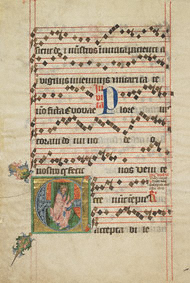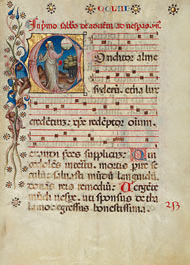Musical chant was an important part of the two main Christian liturgical (ritual) ceremonies: the mass (the public ceremony in which bread and wine are blessed and consumed) and the divine office (the prayer services celebrated by monks and nuns at eight specific times throughout the day). The following types of books, usually written in Latin, evolved to meet the needs of the monks, priests, nuns, and choirs who performed these ceremonies.
|
 |
|
|
 |
Gradual
Graduals are books that contain all the chants sung by a choir in the mass.
Medieval music books grew in size over time to accommodate the many choir members who sang from them at once. This page is over three feet high. The clearly legible music, with individual square notes written on a five-line staff, allowed a large group of singers to read and sing from it simultaneously.
Learn about another gradual featured in this exhibition.
|
 |
|
|
 |
Missal
A missal contains the spoken prayers and chants performed by priests during the mass.
This image from a missal illustrates how music manuscripts were used during the mass. A priest standing before an altar raises the consecrated (blessed) bread of the Eucharist as the faithful kneel in prayer around him. To the left of the priest, several monks gather around a lectern and sing from a choir book.
This scene depicts the act of Transubstantiation—the climax of the mass, when the bread and the wine were mystically transformed into the body and the blood of Christ.
Learn about another missal featured in this exhibition.
|
 |
 |

|
 |
 |
Initial E: The Prophet Isaiah from an antiphonal, Circle of the Master of the Golden Bull, about 1405
|
 |
 |
|
 |
Antiphonal
An antiphonal, also called an antiphonary, contains the chants sung by a choir during the divine office.
This initial E from an antiphonal introduces the Latin phrase "Ecce nunc tempus acceptabile" (Now is the acceptable time), a biblical passage stating that the time of salvation is at hand.
Within the E, the prophet Isaiah raises his right hand to emphasize the Latin phrase that the letter introduces. The green textile—decorated with delicate birds—on his throne signifies his importance.
Learn about another antiphonal featured in this exhibition.
|
 |
|
|
 |
Breviary
A breviary contains the spoken prayers and chants performed by monks and nuns during the divine office.
The text and music shown on this page, dedicated to God, the "nurturing creator of the stars," are among the sung and the spoken prayers used in the divine office. In most cases, monks memorized the chant melodies, but more elaborate musical passages like this one required written musical notation.
The initial C depicts God wearing a sweeping pink and gray robe as he creates the elements of the world with a touch of his finger.
Learn about another breviary in the Museum's collection.
|
 |



